The Mexican Violetear (Colibri thalassinus) emerges as a jewel among hummingbirds, captivating both ornithologists and nature enthusiasts alike with its breathtaking beauty and unique characteristics.
Endemic to montane and subtropical forests, this species thrives in altitudes ranging from 1,000 to 3,000 meters, showcasing remarkable adaptations to high-elevation environments.
Renowned for its dazzling plumage, featuring iridescent shades of violet, green, and blue, the Mexican Violetear is a masterful aerial acrobat, engaging in intricate displays during courtship and territorial defense.
Beyond its aesthetic allure, this hummingbird plays a crucial role in ecosystem health as a pollinator, transferring pollen between flowers while feeding on nectar.
We delve into the life history, nesting details, and fun facts surrounding the Mexican Violetear, underscoring the importance of conservation efforts to preserve its habitat and ensure its continued presence in the rich tapestry of biodiversity.
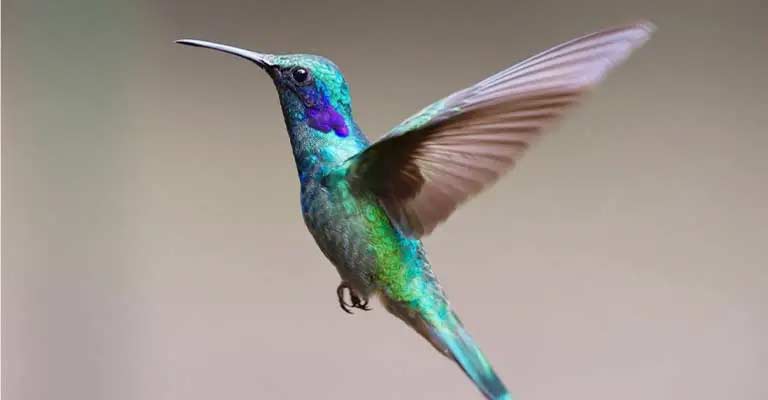
Identifying Characteristics of Mexican Violetear
The Mexican Violetear (Colibri thalassinus) is a captivating and vibrantly colored hummingbird that inhabits parts of Mexico and Central America.
Identifying this particular species requires a keen eye and an appreciation for the subtle nuances of its physical characteristics and behavior.
Physical Appearance
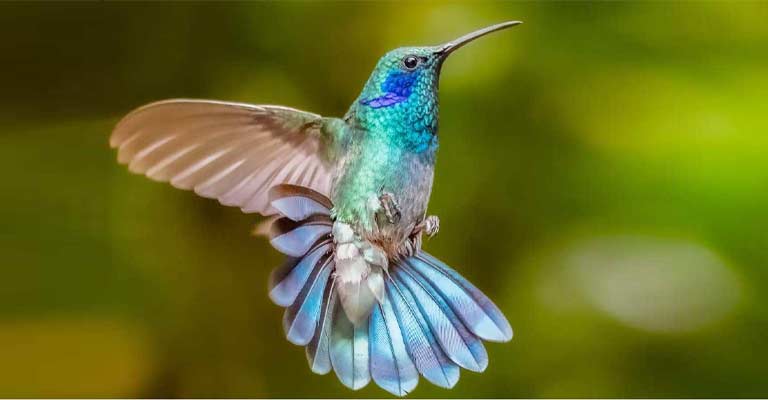
The Mexican Violetear is renowned for its striking plumage, featuring a dazzling combination of iridescent greens and purples.
Its upperparts are predominantly iridescent green, while the throat and breast showcase brilliant shades of violet or purple, giving the bird its distinctive name.
The wings and tail exhibit a slightly darker hue, contributing to the overall vibrant appearance.
The bird’s size is another essential feature for identification. Measuring approximately 4 to 5 inches in length, with a wingspan of 6 to 7 inches, the Mexican Violetear falls within the medium-sized range for hummingbirds.
Facial Markings
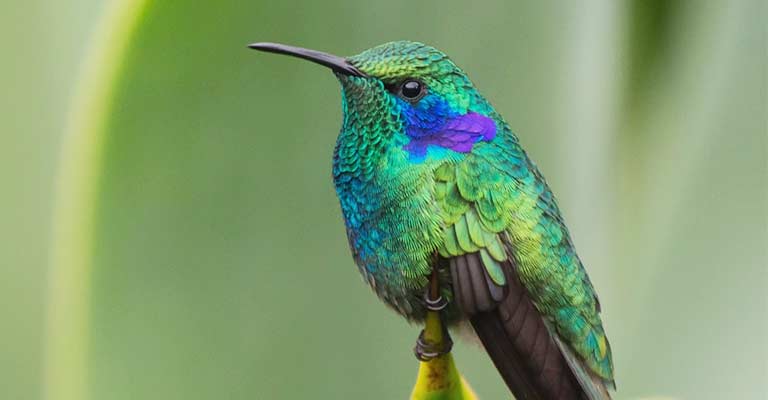
The Mexican Violetear boasts unique facial markings that aid in its identification. One key feature is the presence of a distinctive white or pale blue stripe behind the eye, extending back and curving downwards.
This eye-catching mark is an important field identifier and contributes to the bird’s overall allure.
Behavioral Traits
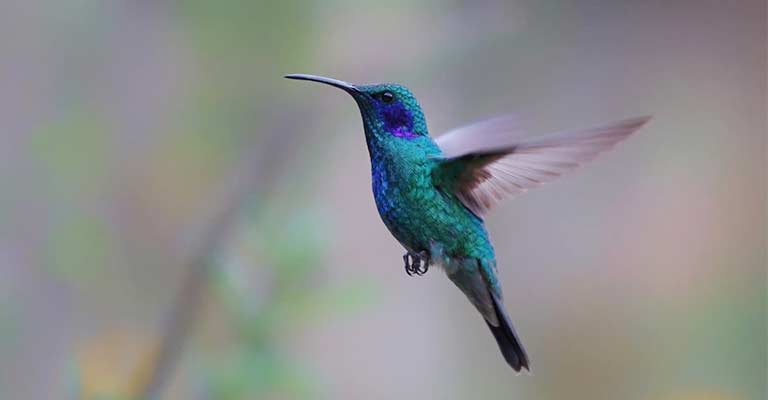
Observing the behavior of the Mexican Violetear can also be instrumental in identification. Like other hummingbirds, it is an energetic and agile flier.
Its rapid wing beats, often reaching 50 to 80 beats per second, allow it to hover effortlessly while feeding on nectar from flowers.
The bird’s specialized long bill and extendable, tube-like tongue are adapted for extracting nectar from flowers, and this feeding behavior is a distinctive trait of hummingbirds.
Habitat and Range
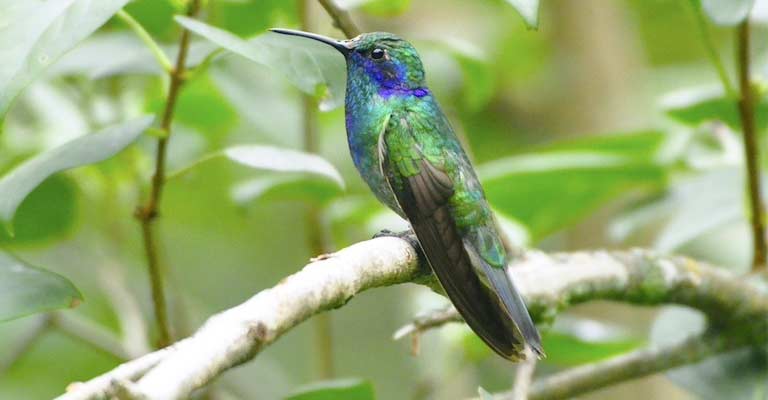
Understanding the habitat and range of the Mexican Violetear is crucial for identification purposes. This species is commonly found in montane forests, cloud forests, and areas with a mix of open spaces and trees.
While it primarily resides in Mexico, its range extends into Central America, including countries like Guatemala and Honduras. Identifying the bird within its specific geographical location provides valuable context for accurate classification.
The Mexican Violetear stands out as a captivating hummingbird species with its vibrant plumage, unique facial markings, and distinctive behaviors.
Bird enthusiasts and ornithologists alike can rely on these key characteristics to confidently identify and appreciate the beauty of this particular avian marvel in its natural habitat.
Taxonomy of Mexican Violetear
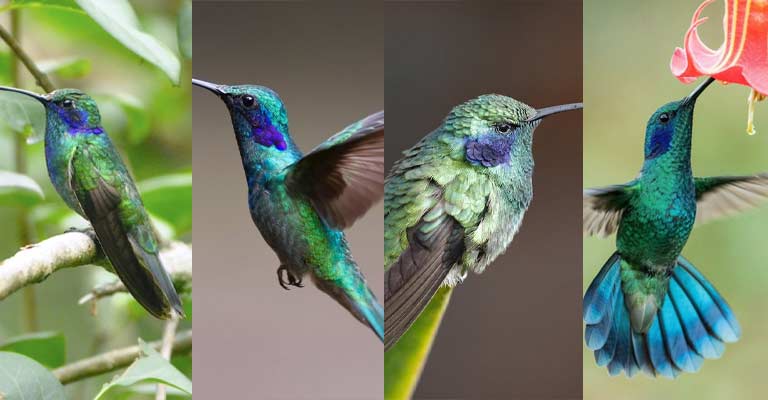
Here is a table outlining the taxonomy details of the Mexican Violetear (Colibri thalassinus):
| Taxonomic Level | Classification |
| Domain | Eukaryota |
| Kingdom | Animalia |
| Phylum | Chordata |
| Class | Aves |
| Clade | Strisores |
| Order | Apodiformes |
| Family | Trochilidae |
| Genus | Colibri |
| Species | C. thalassinus |
The Mexican Violetear belongs to the Eukaryota domain, Animalia kingdom, Chordata phylum, Aves class, and Apodiformes order. Classified under the Strisores clade and Trochilidae family, this bird is part of the Colibri genus.
Its taxonomy reflects its position within the diverse world of birds, showcasing its evolutionary relationships and highlighting its membership in the hummingbird family.
As a species, C. thalassinus is characterized by its vibrant plumage and distinctively long, slender bill, making it a fascinating representative of the avian biodiversity found within the intricate tapestry of life.
Mexican Violetear Life History
The Mexican Violetear (Colibri thalassinus) is a captivating hummingbird species, renowned for its vibrant plumage and distinctive features.
This small bird exhibits an intriguing life history shaped by its interactions with the environment and its unique reproductive and behavioral traits.
Food
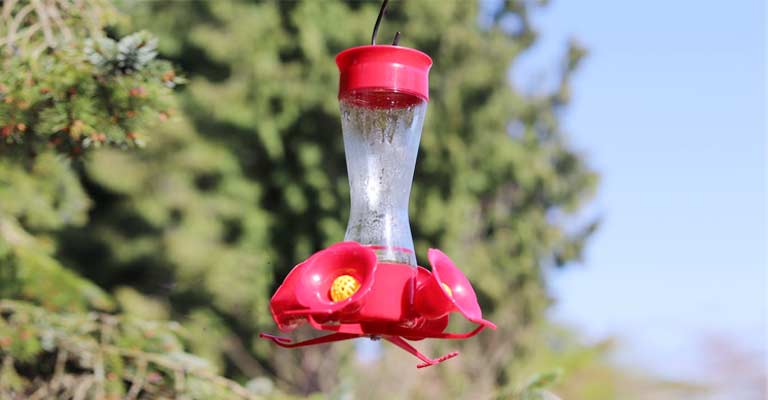
Mexican Violetears primarily feed on nectar from various flowering plants, using their specialized long bills and extendable, tube-like tongues for efficient nectar extraction.
Their diet is supplemented with small insects and spiders, providing essential proteins and nutrients.
Habitat
These hummingbirds are typically found in montane and subtropical forests, preferring altitudes ranging from 1,000 to 3,000 meters.
They thrive in environments with a variety of flowering plants, which serve as a crucial food source.
Range Map
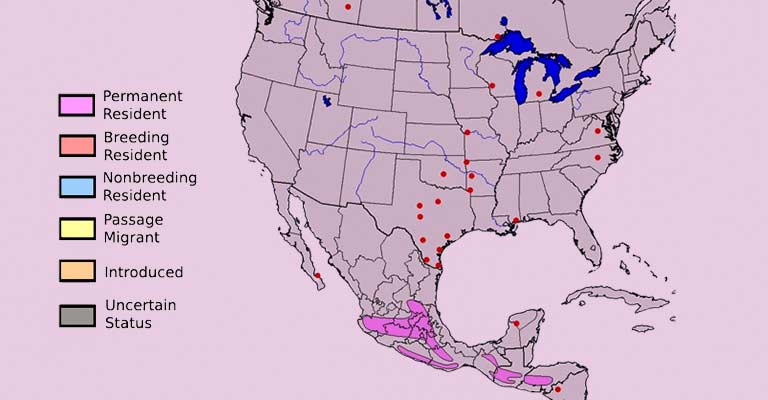
The range of Mexican Violetears extends across Mexico and parts of Central America.
Their distribution is influenced by the availability of suitable habitats and flowering plants, and their range map highlights their adaptability to diverse ecosystems.
Nesting
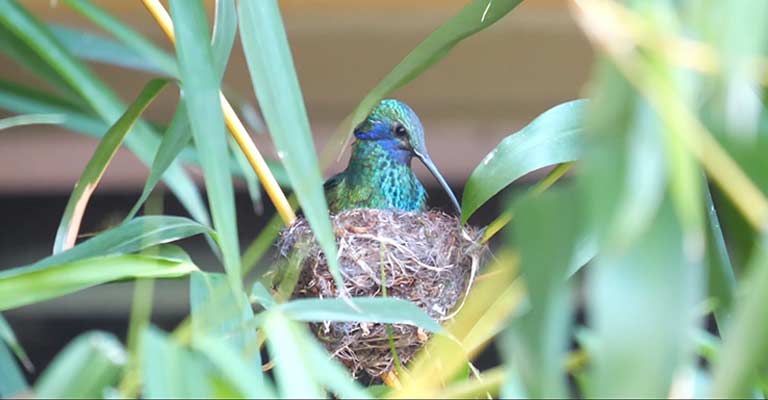
Nesting behavior involves the female constructing a cup-shaped nest using plant fibers, spider silk, and other soft materials. The nests are strategically placed on branches, providing shelter for the eggs and young chicks.
Here is a table outlining nesting details of the Mexican Violetear (Colibri thalassinus):
| Nesting Details | Facts |
| Clutch Size | 1 to 3 eggs |
| Number of Broods | Typically 1 |
| Egg Length | Approximately 1.5 centimeters |
| Egg Width | Around 0.8 centimeters |
| Incubation Period | About 15 to 18 days |
| Nestling Period | Approximately 20 days |
| Egg Description | White, small, and elongated |
| Nest Construction | Cup-shaped, using plant fibers, spider silk, and soft materials |
| Nest Placement | Positioned on branches, often in sheltered locations |
| Parental Involvement | Both males and females participate in incubation and feeding |
| Breeding Season | Typically during the rainy season when food resources are abundant |
Breeding
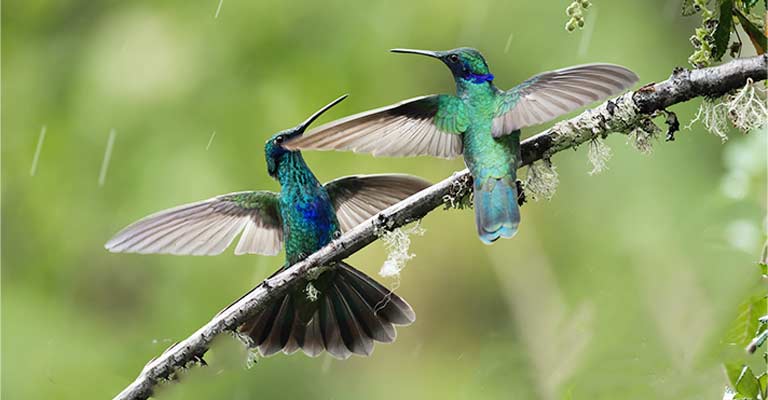
Breeding typically occurs during the rainy season when food resources are abundant. Males engage in elaborate courtship displays, showcasing their colorful plumage and aerial acrobatics.
Female Violetears lay one to three eggs, and both parents play roles in incubation and feeding.
Diseases
Like many bird species, Mexican Violetears may be susceptible to diseases, with common threats including parasites and fungal infections. Monitoring their health is crucial for maintaining stable populations.
Treatment
Effective treatment involves comprehensive veterinary care, including medication for specific diseases, maintaining a clean environment to prevent infections, and providing proper nutrition to support overall health.
Conservation
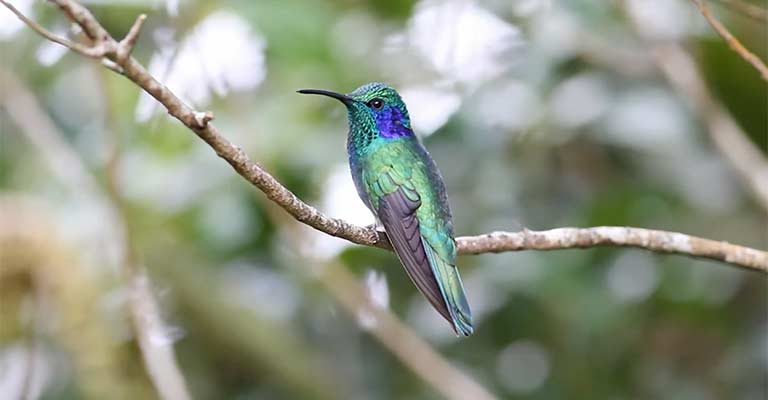
Conservation efforts are vital to ensure the survival of Mexican Violetears.
Protecting their natural habitats, promoting sustainable practices, and raising awareness about the importance of these birds in pollination contribute to their long-term conservation.
The Mexican Violetear’s life history underscores its role in maintaining ecosystem balance, emphasizing the need for conservation measures to safeguard this enchanting hummingbird species.
10 Fun Facts of Mexican Violetear
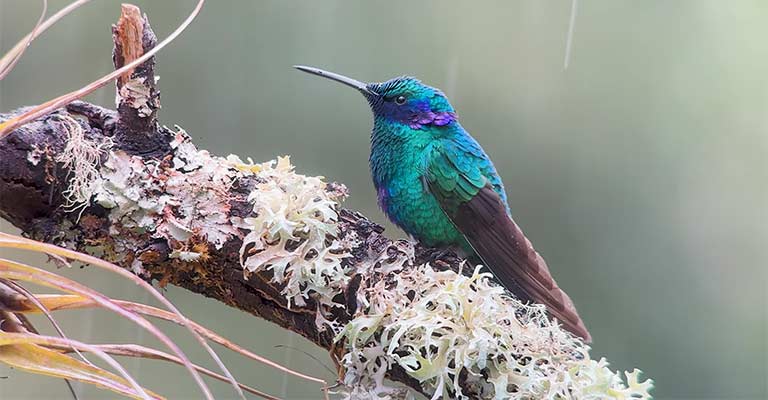
Here are some fun facts about the Mexican Violetear (Colibri thalassinus):
- Dazzling Plumage: Mexican Violetears boast stunning, iridescent plumage featuring shades of violet, green, and blue. The colors change as the bird moves, creating a dazzling display.
- High-Elevation Hummer: These hummingbirds are well-adapted to high-altitude environments, often found in montane and subtropical forests at elevations ranging from 1,000 to 3,000 meters.
- Aerial Acrobats: Mexican Violetears are agile and skilled fliers, capable of intricate aerial maneuvers. Their acrobatic displays are not only for courtship but also play a role in territorial defense.
- Floral Guardians: As avid nectar feeders, they contribute to pollination by transferring pollen between flowers as they feed, inadvertently aiding in the reproduction of various plant species.
- Rainy Season Romance: Breeding for Mexican Violetears typically occurs during the rainy season when flowers are abundant, ensuring a steady supply of nectar for the growing family.
- Tiny Nests: The female builds small cup-shaped nests using materials like plant fibers and spider silk. These nests are strategically placed on branches and provide a secure environment for the eggs and nestlings.
- Parental Cooperation: Both male and female Mexican Violetears actively participate in incubating the eggs and feeding the nestlings, demonstrating a cooperative parenting approach.
- Distinctive Calls: While generally known for their humming sound during flight, Mexican Violetears also produce distinctive calls, adding to the auditory richness of their habitat.
- Migration Patterns: Although some hummingbirds are known for long migratory journeys, the Mexican Violetear is mainly a resident species, with populations residing in their preferred high-altitude habitats year-round.
- Conservation Concerns: Like many hummingbirds, the Mexican Violetear faces threats from habitat loss, climate change, and potential disruptions to their food sources. Conservation efforts are crucial to safeguard these captivating birds.
These fun facts highlight the unique characteristics and behaviors of the Mexican Violetear, making it a fascinating species within the world of hummingbirds.
Wrapping Up
The Mexican Violetear (Colibri thalassinus) stands as a remarkable species, captivating enthusiasts with its vibrant plumage, high-altitude adaptations, and aerial prowess.
From its intricate nesting habits to its vital role in pollination, this hummingbird offers a glimpse into the intricacies of avian life.
As we explore its life history, nesting details, and fun facts, it becomes evident that the conservation of these enchanting birds is paramount.
Habitat protection, sustainable practices, and public awareness play crucial roles in ensuring the continued presence of the Mexican Violetear in our diverse ecosystems.
By appreciating and understanding these tiny aerial wonders, we contribute to the broader narrative of biodiversity preservation and environmental stewardship.